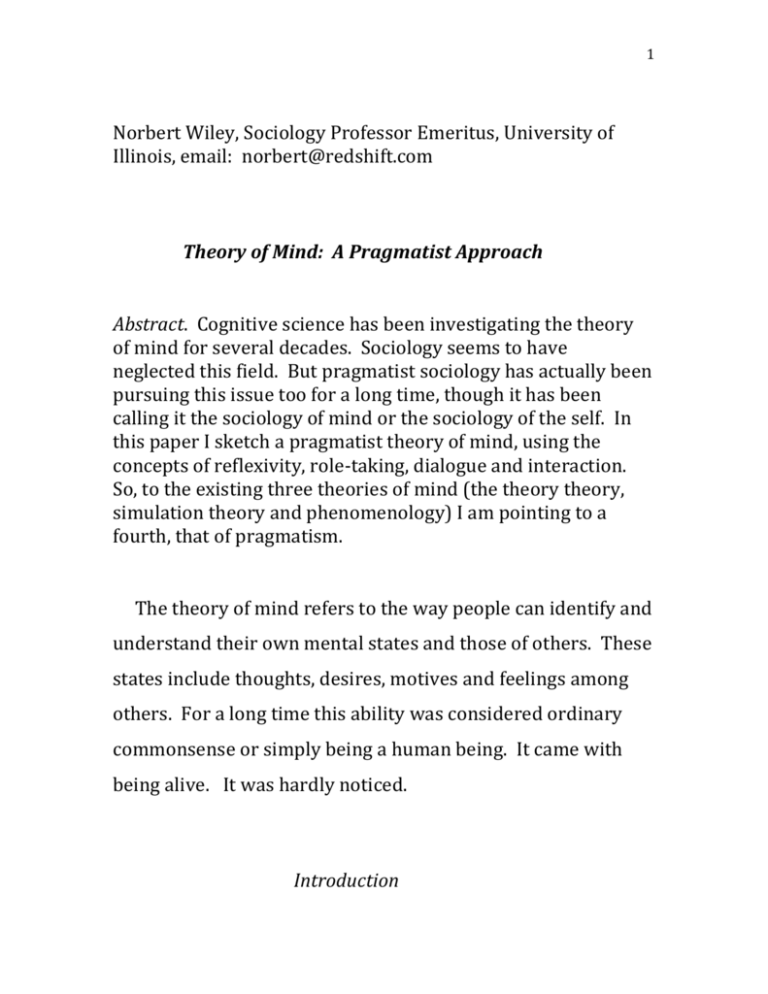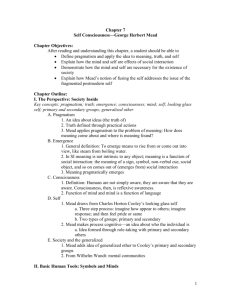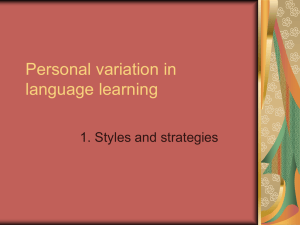Theory of Mind
advertisement

1 Norbert Wiley, Sociology Professor Emeritus, University of Illinois, email: norbert@redshift.com Theory of Mind: A Pragmatist Approach Abstract. Cognitive science has been investigating the theory of mind for several decades. Sociology seems to have neglected this field. But pragmatist sociology has actually been pursuing this issue too for a long time, though it has been calling it the sociology of mind or the sociology of the self. In this paper I sketch a pragmatist theory of mind, using the concepts of reflexivity, role-taking, dialogue and interaction. So, to the existing three theories of mind (the theory theory, simulation theory and phenomenology) I am pointing to a fourth, that of pragmatism. The theory of mind refers to the way people can identify and understand their own mental states and those of others. These states include thoughts, desires, motives and feelings among others. For a long time this ability was considered ordinary commonsense or simply being a human being. It came with being alive. It was hardly noticed. Introduction 2 But when academics starting using Turing’s analogy between computers and humans, and as this analogy became more popular, it became obvious that computers lacked the theory of mind. Computers themselves have no mental states nor can they recognize the mental states of others. To put it another way, the computer analogy has produced two opposed insights: one is how computers are like people and the other is how they are not like people. The differences are as illuminating as the similarities. The theory of mind was identified in Nicholas Humphrey’s 1983, Consciousness Regained: Chapters in the Development of Mind, a book which drew on papers as old as the early 1970s. Another signpost was Simon Baron-Cohen’s 1995, Mindblindness: An Essay on Autism and the Theory of Mind. In this book the author showed that autistic children have little or no theory of mind, i.e. little understanding of the mental states of others. Baron-Cohen’s writings on this issue actually began in the early 1980s. So the absence of a theory of mind in computers and also in autistic children drew scholarly attention to this previously ignored skill of human psychology. 3 Another historical development that popularized the theory of mind was the gradual appreciation and upgrading of “folk psychology” (Horgan, Terence and James Woodward, 1985, Davies and Stone, 1995; Hutto, 2008). This psychology was originally, in the 1960s and 1970s, considered mere common sense, in the negative connotation of that term. Common sense and folk psychology were initially regarded as inferior kinds of knowledge. For example a common put-down was to say that common sense had claimed the world is flat, but science has shown that it is round. The folk psychology or theory of mind was originally thought of as a pre-scientific and crude picture of psychological reality. But gradually it became clear that the theory of mind was not only a relatively powerful kind of knowledge, it was also unlikely that scientific psychology would ever discover a more accurate theory. In fact it became apparent that psychology would probably never produce a first person theory of mental states at all, since these experiences can be understood only by introspection in the self and empathy with others. To put it another way, there are two kinds of folk science, 4 physical and cultural. Folk physical science, for example that the world is flat, is obviously inferior to professional physical science. But folk socio-cultural science, including the social psychological insights we have by just being human, is often superior to professional science. Explanations of the Theory of Mind In the field of cognitive science the theory of mind was initially explained with something called, a bit clumsily, the “theory theory.” This was the idea that people used a cognitive scheme, akin to a scientific theory, to discern each other’s mental states and to predict each other’s behavior. This was also the view that people held theories about each other which enabled them to understand each other’s “intentionality” (in Edmund Husserl’s sense), that is, beliefs, desires purposes, etc. To make this argument, the idea of “folk psychology” was elevated from a pre-scientific and casual interpretive scheme into one which was amazingly accurate and far better than anything cognitive science could produce. To put it another way, what the computer couldn’t do, read minds, the ordinary person could do. The only problem was in figuring out how people did this, or explicating the theory people used in 5 exercising this process. Cognitive science has been unable to explicate mind reading. This problem was gradually confronted by another explanation called the “simulation theory.” This was the idea that people imagined or simulated what was in other’s minds. With this psychological device they were able to figure out the mental states of others. In a sense the missing theory turned out to be the simulation process. But it proved impossible to explain convincingly how people could simulate each other’s mental states, and this approach, like the theory theory, was unsatisfactory. The one new strength of simulation was the discovery that mirror neurons “lit up” in the brain when people simulated each other’s behavior, suggesting that simulation was neurologically based. However the mirror data was subject to more than one interpretation. Among other difficulties, it was not clear whether the mirror process was cause or effect of simulation. When the two cognitive science initiatives proved to be of limited power, the scholars of Husserl’s phenomenology, 6 joined the discussion (Gallagher and Zahavi, 2008, pp. 171196) These thinkers had a sophisticated set of concepts from Husserl, and they did not use the computer analogy. Husserl’s ideas were initially formed primarily for understanding the mental states of the self. But Alfred Schutz, among others, had applied Husserl to the social world, showing, for example, that ordinary social encounters require a phenomenological epoche or reduction, that is, a suspension of disbelief (Schutz, 1973, p. 229). Contemporary phenomenologists have shown that it is in social interaction where people open their minds to each other. In particular people’s gestures, intonations, facial attitudes and speech reveal their minds. We know people’s mental states, not through a theory or through simulation, but by the way they reveal themselves to us (Gallagher, 2004). This approach had a distinct power, but it did not fully explain the depth and accuracy of mind reading. I have now laid out the three approaches to the theory of mind: (a) the theory theory, (b) the simulation theory, and (c) the phenomenological approach. Given that all three of these have their limits, I want to introduce the social psychology of American pragmatism as a fourth approach. This discipline -- 7 based primarily on the thought of John Dewey, Charles Sanders Peirce, William James and George Herbert Mead -- has a rich set of concepts, and these ideas were especially formed for the analysis of mental states (Franks, 2010, Hopcroft, 2013). Neo-pragmatists have been developing this theory for a long time, a relatively early statement being Randall Collins’ “Toward a Neo-Meadian Sociology of Mind” in 1989. Both before and after Collins’ paper there has been continuous research on pragmatism’s theory of mind. But this work has been done with little reference to cognitive science and phenomenology’s ideas. My paper is, in part, a re-naming of pragmatism’s research. Instead of “sociology of mind” I am making the obvious observation that it is also engaged in forming a “theory of mind.” The Pragmatist Social Psychology as a New Approach I will first point out how cognitive science’s computer analogy looks from a pragmatist point of view. Perhaps the main criticism would be that, although the computer can 8 handle syntax and similar formalizations, it cannot handle semantics or meaning or understanding (Horst, 2011, pp. 123144, Searle, 1980, Sayre, 1987). In addition the computer lacks emotions and imagination. The strength of a pragmatist theory of mind is that it can handle meaning, emotion and imagination. At present cognitive science cannot reach what might be called the psychological interiority of human life. This is the same realm as Husserl’s intentionality and the pragmatists’ sphere of meaning. There can be no satisfactory theory of mind without an explanation of this psychological interiority. The thesis of this paper, then, is that pragmatist social psychology has the best means for explicating this interiority and the theory of mind. Outline of the pragmatist theory This paper is meant to be only a sketch, a series of themes that I think would be useful for a theory of mind. I will not try to mine the substantial pragmatist literature that already exists 9 on this topic. My sketch will draw on some of these resources but it is only a first stab, and it will take some time and effort to more fully organize the pragmatist theory of mind. A theory of mind needs to explain two things. How humans know their own mental states and how they know those of others. I will show, as this discussion proceeds, how pragmatism answers these two questions. My outline of the pragmatist theory will rest on four themes: reflexivity, roletaking, dialogue and interaction sui generis. Reflexivity and role-taking are both based on Mead, although many scholars have further developed these ideas. Dialogue will add Mikhail Bakhtin’s addressivity to Mead’s role-taking, a move first suggested by Robert Perinbanayaban (1991, pp. 6-7). The fourth concept, interaction as a sui generis, ontological level, was first introduced by Erving Goffman (1967). Later, his somewhat programmatic insight was clarified and put to use by Anne Rawls (1987). This batch of ideas is only one way of constructing a pragmatist theory of mind. Other ideas in the wings are Dewey’s notion of embodiment (Solymosi, 2011), James’ concept of self-feeling and Peirce’s theory of semiotic. 10 Reflexivity. The term reflexivity has more than one meaning in social psychology (Archer, 2010), but I want to single out the usage most relevant to this paper. By reflexivity Mead usually meant self-awareness or psychological contact with oneself. In fact he defined the self as the reflexive entity (Mead, 1934, p. 136) The flexing here, to use a spatial metaphor, is an act which goes out of the self and then bends back in a kind of “U-turn” and returns to the self. If this were a visual act it would go out to some kind of reflecting device such as a mirror and then go back to the self, thereby visualizing the self or getting into contact with oneself. Another analogy is that we look out to another person, take their role, and then look back at our self from the standpoint of the other. This is in some ways a better analogy because it is closer to the way, in child development, the baby attains reflexivity. Baby first identifies with the close caretaker, usually the mother, and has something of a merger with her. This merger gradually goes through stages of separation as the baby moves toward autonomy and independence from the caretaker (Mahler, Pine and Bergmann. 1975). When the baby 11 can take the role of the mother and look back at him- or herself through the eyes of the mother, baby has attained an early form of self- awareness or reflexivity. I am skipping over the empirical findings of child development research because I want to describe this process in bold strokes. There are actually several sub-stages and complexities, but these are not relevant to the present, summary description. The notion of introspection, which means self-awareness or self -observation, is the same as reflexivity. When we have reflexive awareness of, say, a thought or an emotion, we engage in ordinary or first order introspection. If we want to take a closer look at one of our mental states we might take an outside or “meta” position and observe our reflexivity therefrom. This might be called second order introspection, because it is distinct from and added to the first order. The intermittent, historical controversy in psychology over introspection has been concerned primarily with second order introspection. But our knowledge of our own mental states, which is a by-product of having these states at all, is based on reflexivity and first order introspection. 12 Second order introspection is also, as I am defining it, the same as second order reflexivity. In first order reflexivity the self is split onto two parts: a reflecting part (referred to, by Mead as the “I”) and a reflected part (referred to by Mead as the “me”.) But in second order reflexivity the self is not split. It is whole. Now the two “parts” are the second order self or “I” at the meta level and the first order self, taken in its entirety, at the first order level. I have now answered the first question, how we understand our own mental states. We know these states because knowledge of them is part of our having them at all. When we have a thought or any other mental state we engage in reflexivity or self-awareness. In addition, having a mental state is a psychological act and it is a form of agency, a thing we do. The major pragmatists all recognized some kind of voluntary quality in our acts. We may sometimes act habitually or automatically, but associated with these habits is an acceptance or permission. In the case of acts that are not habitual, which we deliberately enact, the 13 voluntary quality is overt and explicit. This volition entails knowledge of the mental acts. As we choose, we know what we are choosing. Given the two processes of reflexivity and volition, we are, to repeat the response to the first question, routinely and continuously aware of our own mental states. This analysis of reflexivity is important partly because sometimes scholars have claimed that the thermostat or the computer, both of which can reflect on themselves, have the same reflexive powers as the self. In saying this, these scholars are over-reaching the computer analogy. These mechanical devices can never reflect on their entirety. There are always the two parts: the reflecting part, e.g. the physical thermostat or the recursive language of the computer, and the reflected part. The self at the second order can reflect on its entirety, but the mechanically reflexive devices can reflect on only part of themselves. Therefore the notion that mechanical reflexivity is the same as psychological reflexivity is a fallacy Role-taking. 14 Role-taking is also one of Mead’s key ideas. It designates a process that is central to the theory of mind. To take the role of another is to empathize in a cognitive manner with them or to step into their mental shoes. Role-taking is essential to the communication process, for it designates how we can establish a meaningful relationship with someone else (Shook, 2013) . It is sometimes thought that humans first become selves and then learn to take the role of others. This two-stage idea is behind many of the excessively autonomous or asocial notions of human nature. Social contract theories and most versions of classical economics are of this character. But for Mead the self is social first and autonomous later. The first acts of reflexivity or self-awareness, as I suggested above, are based on role taking. When we are infants, our caretaker addresses us with hugs, loving gaze, billing and cooing and all-encompassing feelings. We identify with that caretaker and his or her role-taking of us. In this way we learn to relate to ourselves in the same manner. We learn to reflect on ourselves by identifying with and role- 15 taking our mothers or mothering one. Initially our role-taking of the mother and our reflexing on ourselves are a single act. Gradually we learn to separate out the way mother role-takes us, the way we engage in reflexivity on ourselves and the way we role-take people other than the mother. It is in this relational matrix that we become selves. The self is inherently social because it is created by a social relation with our caretaker. In addition its internal structure – the dialogue of what Mead called the I and the me and Peirce called the I and the you -- is based on the relation to the caretaker. She (Mom) gradually becomes “me,” that is, the partner in our internal dialogue. Given this social birth of the self, the “feel” for the minds of others usually comes naturally. The phenomenologists are certainly right, we know the minds of others because others reveal themselves to us (Gallagher and Zahavi, p. 188). But the pragmatists’ view of the social self also helps explain our knack for interpreting the minds of others. Sociability and communication are what gave us a self in the first place. We have these traits connaturally, by which I mean we know them because we are them. 16 Dialogue. The notion of role-taking can be enhanced by adding Mikhail Bakhtin’s notion of dialogue. For Bakhtin dialogue is not something selves do; it is what selves are. As he put it Life by its very nature is dialogic. To live means to participate in dialogue: to ask questions, to heed, to respond, to agree, and so forth. In this dialogue a person participates wholly and throughout his whole life: with his eyes, lips, hands, soul, spirit, with his whole body and deeds. He invests his entire self in discourse, and this discourse enters into the dialogic fabric of human life, into the world symposium (Baktin, 1984, p. 293) Bakhtin regards dialogue as close, such that we are intimately attentive to the psychological traits of each other (Peringanayagam 1991, pp. 6-7). For Bakhtin, when we address another we take into account their entire personality 17 and all the traits that we want to speak to. We talk not only to them but to all of their “states of mind.” In other words mind reading, to Bakhtin, is a normal and routine part of dialogue. Interaction sui generis. Erving Goffman worked with role-taking in his notion of interaction as a kind of reality (Goffman, 1967, Scheff, 2006). For him when we communicate we encounter the other in a unique field. When Anne Rawls (1987) called Goffman’s idea “interaction sui generis” she was designating an ontological level, (Wiley, 1994, pp. 137-141) mediating between the individual and the social structure. This level, to return to theory of mind, has emergent properties. And it is these properties that permit the dialogue and mental closeness between the participants. In addition to the obvious cues, such as words, bodily gestures, dress, facial expressions, changes in voice, etc. the doors can be opened between the two selves. This opening is a characteristic of this level, and it helps explain how two people can understand each others’ mental states. 18 An analogy is a ritual crowd in which everyone shares intense solidarity and knows what is in each others’ mind. It is the crowd’s consciousness and shared beliefs that is in these minds. Goffman thought that all interaction had a ritual quality, which could create a kind of charisma between the participants. A ritual bond is an extreme case of interaction sui generis, but it designates the dynamic of the mind reading process. What I am saying then, to return to the second question, is that people discover each other’s mental states in the process of interaction. The closer the interaction and the more frequent its occurrence, the more likely this process will work well. Once interaction sui generis is attained, there is a legitimacy to rendering and expecting some self disclosure. The semiotics or cues of this state already begin this disclosure, and the flow of interaction will usually enhance it. Conclusion. 19 In this paper I described a theory of mind, a specialty which began in cognitive science several decades ago. This specialty has also been pursued in pragmatist social psychology for a long time, though it has gone on under other names, such as sociology of mind or the theory of the self. I used major concepts from pragmatism to sketch my version of this theory. This is obviously not meant to be a finished theory, nor can I claim to be identifying and using all the conceptual resources of pragmatism. Still I did give answers to sociology of mind’s two major questions. These answers draw on the unique resources of pragmatist theory, so I think it is reasonable to say they make a contribution to the ongoing discussion concerning the theory of mind. REFERENCES Archer, Margaret S. “The Reflexive Re-Turn.” Pp. 1-13 in Margaret Archer, Ed., Conversations about Reflexivity. London: Routledge, Taylor and Francis Group. Baron-Cohen, Simon. 1995. Mindblindness: An Essay on Autism and Theory of Mind. Cambridge: The MIT Press. 20 Carruthers, Peter. 2011. The Opacity of Mind: An Integrative Theory of Self-Knowledge. Oxford: Oxford University Press. Collins, Randall. 1989. “Toward a Neo-Meadian Sociology of Mind.” Symbolic Interaction. 12:1-32 Davies, Martin and Tony Stone, eds. 1995. Folk Psychology: Readings in Mind and Language. Oxford: Blackwells Franks, David D. 2010. Neurosociology. New York: Springer. Gallagher, Shaun. 2004. “Understanding Interpersonal Problems in Autism: Interaction Theory as an Alternative to Theory of Mind. 11:199-211 21 Gallagher, Shaun and Dan Zahavi, 2008. The Phenomenological Mind, London: Routledge Taylor and Francis Group. Goffman, Erving. 1967. Interaction Ritual. New York: Doubleday Anchor Hopcroft, Rosemary L. 2113. “Neursociology and Theory of Mind (ToM)” in David D. Franks and Jonathan H. Turner, eds., Handbook of Neurosociology, London: Springer Horgan, Terence and James Woodward. 1985. “Folk Psychology is Here to Stay.” The Philosophical Review. 94:197226. Horst, Steven W. 2011, Symbols, Computation, and Intentionality: A Critique of the Computational Theory of Mind. Charleston: CreateSpace 22 Humphrey, Nicholas. 1983. Consciousness Regained: Chapters in the Development of Mind. Oxford: Oxford University Press. Hutto, Daniel D. 2008. Folk Psychology Narratives. Cambridge: MIT Press Johnson, Mark. 2006. “Cognitive Science.” Pp. 369-377 in John R. Shook and Joseph Margolis, eds., A Companion to Pragmatism. Oxford: Blackwell Mahler, Margaret, Fred Pine, and Anni Bergman. 1975. The Psychological Birth of the Human Infant, New York: Basic Books. Mead, George Herbert. 1934. Mind, Self, and Society. Chicago: University of Chicago Press. 23 Perinbanayagam, R. S. 1991. Discursive Acts. New York: Aldine De Gruyter Premack, David and Guy Woodruff. 1978. “Does the Chimpanzee have a Theory of Mind?” Behavioral and Brain Sciences. 4:515-526. Rawls, Anne. 1987. “The Interaction Order Sui Generis: Goffman’s Contribution to Social Theory.” Sociological Theory. 5:136-149. Sayre, Kenneth. 1987. “Cognitive Science and the Problem of Semantic Content.” Behavioral and Brain Science. 70:247269 Scheff, Thomas. J. 2006. Goffman Unbound: A New Paradigm for Social Science. Boulder: Paradigm Publishers 24 Searle, John R. 1980. "Minds, Brains and Programs", The Behavioral and Brain Sciences. 3:417-424. Schutz, Albert. 1973. Collected Papers. Volume 1, The Hague: Martinus Nijhoff Solymosi, Tibor. 2011. “Neuropragmatism: Old and New.” Phenomenology and Cognitive Science. 10:347-368. Shook, John R. 2013. “Social Cognition and the Problem of Other Minds.” In David D. Franks and Jonathan H. Turner, eds., Handbook of Neurosociology, London: Springer. Tallis, Raymond. 2011. Aping Mankind. Durham: Acumen Wiley, Norbert 1995. The Semiotic Self. Chicago: University of Chicago Press. 25


![Reflexivity in Academic Research [.PPT]](http://s2.studylib.net/store/data/005467615_1-5f1ed51efa2e2c6daa464b130d515ef6-300x300.png)


